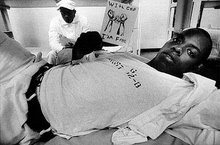 1 cup Quinoa - Whole Foods
1 cup Quinoa - Whole FoodsFresh Mint - home grown
1 Organic Non GMO Tomato - farmer's market
1 Green onion - farmer's market
1 Head Organic Lettuce - farmer's market
Lemon Juice - farmer's market
Parsely - home grown
Sprout Quinao for 4 hours
drain
chop mix
serve
@ $3.00
Her Side said...
 "Quinoa may be germinated in its raw form to boost its nutritional value. Germination activates its natural enzymes and multiplies its vitamin content.[6] In fact, quinoa has a notably short germination period: Only 2–4 hours resting in a glass of clean water is enough to make it sprout and release gases, as opposed to, e.g., 12 hours overnight with wheat. This process, besides its nutritional enhancements, softens the grains, making them suitable to be added to salads and other cold foods."
"Quinoa may be germinated in its raw form to boost its nutritional value. Germination activates its natural enzymes and multiplies its vitamin content.[6] In fact, quinoa has a notably short germination period: Only 2–4 hours resting in a glass of clean water is enough to make it sprout and release gases, as opposed to, e.g., 12 hours overnight with wheat. This process, besides its nutritional enhancements, softens the grains, making them suitable to be added to salads and other cold foods."Thanks for taking us to school again on nutrition, DV. Gonna hit Whole Foods market next pay cycle...
















































































































11 comments:
Looks good. Any sauce for the salad or Dressing?
Stop it already with the LaRouchian Propaganda DV.
lol
"Quinoa may be germinated in its raw form to boost its nutritional value. Germination activates its natural enzymes and multiplies its vitamin content.[6] In fact, quinoa has a notably short germination period: Only 2–4 hours resting in a glass of clean water is enough to make it sprout and release gases, as opposed to, e.g., 12 hours overnight with wheat. This process, besides its nutritional enhancements, softens the grains, making them suitable to be added to salads and other cold foods."
Thanks for taking us to school again on nutrition, DV. Gonna hit Whole Foods market next pay cycle...
Social Context May Be a Better Indicator of Obesity Disparities than Race
When analyzing obesity disparities among women, socioeconomic status and social context may be more important than race, according to a study by researchers at the Johns Hopkins Bloomberg School of Public Health’s Hopkins Center for Health Disparities Solutions. The authors examined race disparities in obesity among black and white women living in the same social context with similar income and compared these estimates to national data. Nationwide, black women were twice as likely to be obese when compared to white women. However, the researchers found that obesity rates were comparable in a sample of white and black women living in similar social and environmental conditions. The results are featured in the May 2010 issue of the Journal of Epidemiology and Community Health.
“In a national sample not accounting for race differences in social context, black women had twice the chance of being obese as compared to white women,” Sara Bleich, PhD, lead author and assistant professor in the Bloomberg School's Department of Health Policy and Management. “To date, efforts to explain the disparity in obesity prevalence have primarily focused on individual level factors and little research has focused on social context as a possible explanation. When we examined poor, urban women exposed to the same environment, race disparities in obesity virtually disappeared.”
Bleich, along with colleagues from the Hopkins Center for Health Disparities Solutions examined race disparities in obesity among black and white women living in the same social context with similar income in Baltimore. Using the data from the Exploring Health Disparities in Integrated Communities-Southwest Baltimore (EHDIC-SWB) study, a cross-sectional face-to-face survey of the adults ages 18 and older, researchers compared estimates to national data from the National Health Interview Survey (NHIS) to determine if the race disparity in obesity was attenuated among women living in the same social context. Obesity was calculated from self-reported height and body weight and logistic regression was used to examine the association between race and obesity.
“Accurately accounting for social and environmental exposures is particularly important for the study of obesity disparities given the growing literature linking individual body weight to a host of environmental factors, both positively and negatively associated with body mass index,” said Thomas LaVeist, PhD, senior author of the study and director of the Bloomberg School’s Hopkins Center for Health Disparities Solutions. “Developing policies that focus on modifying social aspects of the environment may reduce disparities in obesity among low-income women living in urban communities.”
What you make of this Big Man?
M. Rigmaiden said...
Looks good. Any sauce for the salad or Dressing?"
Hey M.
Olive Oil, lemon juice and UNREFINED mineral rich salt. (Critically important)
Himilayan Pink Salt is our favorite.
Can't get that ... or still pretending like you don't get it ... go with a product called "Real Salt". It too is mineral rich and UNREFINED.
Which means it does not contain the toxic chemical byproducts that occurs in commercial grade industrialized salt (99% of the salt on the market).
My man!! Tell Kellie that salad almost looks as beautiful as she does! Thank GOD for real,beautiful women who can put their foot in a all NATURAL HEALTHY meal and make it taste great!!Like DV says "if you don't have a woman....get one"! I got one and she does the exact same thing for me! Give our LOVE to the fam!!
one love,
kid blaze
DV don't put words in my mouth. I never ragged on you guys about the himalayan pink salt. I use a variety of salts in my larder including Vegesal.
This looks so good I could eat it from the screen. I will have to try it even though it is winter here. Thanks for alerting me to the easy preparation of quinoa.
Not about the salad, but this link does support the health meme you kick.
They've got inmates growing their own food in CT...and in an unrelated study, the greatest predicter of an inmates future behavior...diet:
http://cryptogon.com/?p=15276
Post a Comment